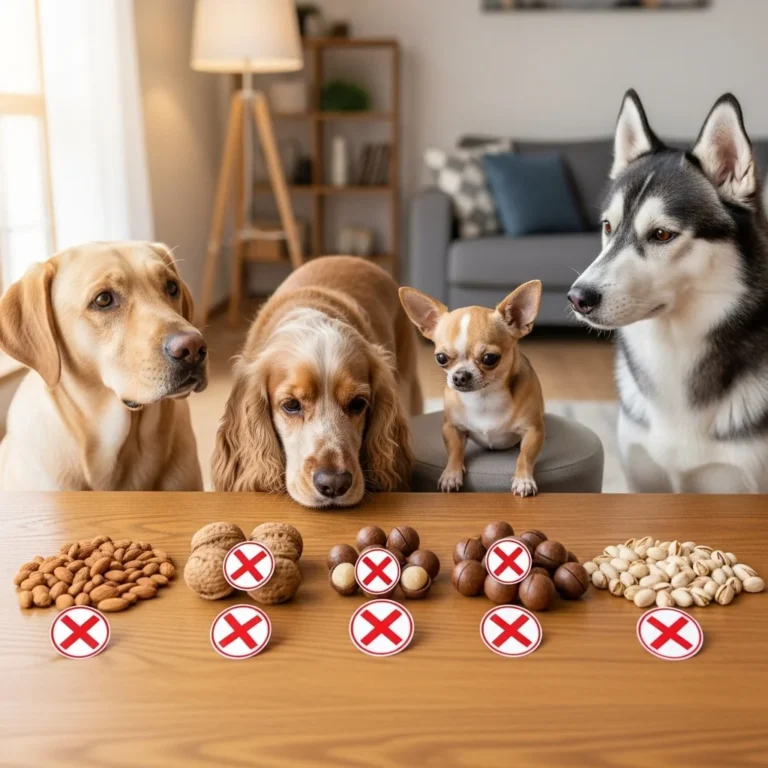
🐶can dogs eat nuts🐶
So, you’re munching on a handful of nuts, and there’s your dog, staring at you with those “please share” eyes. And then it hits you: Can dogs eat nuts?, what nuts can dogs eat.
You’re not alone in wondering this! A lot of dog parents have been there (and maybe already caved). The truth? It’s not a simple yes or no — it’s more like “some are okay in tiny bits, others… absolutely not.”
In this guide, we’ll chat about which nuts are safe, which are dangerous, and how to handle it if your pup sneaks one off the floor. I’ll also drop in what actual vets say about all this — so it’s not just random internet wisdom. Ready? Let’s crack this open. 🥜
🥜 1. Nuts That Are Generally Safe (in Moderation)
Can dogs eat peanuts safely?
Good news first — peanuts are usually safe if they’re plain, unsalted, and shelled. (source) Yep, your pup can have one or two as a treat now and then.
But — and it’s a big but — they’re still super fatty. (source) Too many can upset your dog’s stomach or even lead to pancreatitis (which is painful and serious). So think of peanuts like the dog version of fries: a rare guilty pleasure, not a snack-time staple.
Are cashews or Brazil nuts okay for dogs in small amounts?
Cashews and Brazil nuts fall into the “technically safe but not really worth it” zone.
According to Purina, cashews aren’t toxic but are basically fat bombs. Brazil nuts are similar — not poisonous, but way too rich, especially for smaller dogs. (source)
So yeah, one tiny piece once in a blue moon won’t hurt, but there are much better treats out there that won’t send your dog’s stomach into a tailspin.
If my dog eats a small amount of a “safe” nut like peanuts, should I still worry?
If it’s just one or two plain peanuts, don’t panic. Chances are your dog will be fine.
Still, keep an eye on them for signs of tummy trouble or anything weird. (source) Every dog’s a little different, so it’s better to play it safe than to be Googling symptoms at 2 a.m.
Are plain, unsalted nuts always safe for dogs?
Nope, not always! Even plain, unsalted nuts can be trouble because of their high fat content or choking risk. (source)
If you’re really set on sharing, make sure it’s a tiny piece, and your dog is chewing it properly. But honestly? There are way better options than nuts — like baby carrots or apple slices.
can dogs eat honey nut cheerios?
Yes, in small amounts, Honey Nut Cheerios are generally safe for most dogs. They don’t contain anything directly poisonous — no chocolate, raisins, or xylitol. So if your pup sneaks a few off the floor, don’t panic.
But… that doesn’t mean they’re a good snack. These cereal rings are made for humans, and they contain sugar, honey, and artificial flavoring — none of which your dog needs in their diet.
🚫 2. Nuts to Avoid or Consider Dangerous
Which nuts are unsafe or toxic for dogs (like almonds, walnuts, macadamia nuts, pistachios, and hazelnuts)?
Here’s the “just don’t go there” list, straight from the pros:
- Macadamia nuts — extremely toxic. (source)
- Walnuts, especially black ones — can carry mold and cause intestinal blockages. (source)
- Almonds — they’re not toxic, but they can easily choke your dog. (source)
- Pistachios and hazelnuts — lots of fat, sometimes mold, and way too easy to overdo. (source)
So yeah, these might look healthy in trail mix, but for dogs, they’re a no-go snack.
Why are some nuts—like macadamias—particularly dangerous for dogs?
Macadamias are the worst offenders. Even a few can make dogs seriously sick — we’re talking vomiting, weakness, tremors, and fever within hours. (source)
Scientists aren’t 100% sure why they’re toxic, but the reaction is dramatic. So if you’ve got macadamia nuts around, keep them far from paw-level.
Is it true that certain nuts become toxic only under specific conditions (moldy, flavored, or salted)?
Totally true!
Moldy nuts can grow mycotoxins — nasty compounds that can poison your dog. (source)
And those salted or flavored kinds? Double trouble. Salt can mess with your dog’s sodium levels, and flavorings often include garlic or onion powder (both toxic). (source)
So yeah, “gourmet nuts” might sound fancy, but they’re basically little landmines for dogs.
⚕️ 3. Health Risks and Possible Reactions
What are the main health risks of feeding nuts to dogs?
Even if your dog doesn’t get into the dangerous kinds, nuts can still cause issues:
- Choking or intestinal blockage. (source)
- Upset stomach or vomiting from too much fat. (source)
- Moldy nuts = mycotoxins = sick pup. (source)
- Added salt, sugar, or coatings can be toxic. (source)
- And of course, health issues like pancreatitis for dogs already prone to tummy troubles. (source)
Moral of the story? Even “safe” nuts can backfire.
Can eating nuts cause pancreatitis in dogs?
Yup, it happens more than you’d think. Because nuts are packed with fat, they can cause pancreatitis, which is a painful, dangerous inflammation of the pancreas. (source)
One too many handfuls of fatty snacks, and suddenly your dog’s in distress. It’s really not worth the risk for a quick treat.
Why is the fat content in nuts a concern for dogs?
Dogs just aren’t built for fatty foods the way humans are. That fat can mess with their digestion, pack on weight, and even trigger health problems. (source)
Think of it like feeding a kid a whole pizza and expecting them to run laps after — not gonna end well.
Can moldy nuts make dogs sick?
Absolutely! Moldy nuts can carry aflatoxin, which is toxic for dogs (and us too, honestly). (source)
Symptoms can include vomiting, tremors, or even seizures. So if your nuts look a little “off,” don’t test your luck — toss them.
How does a dog’s size, diet, or health condition affect how risky nuts are?
Smaller dogs and those with health issues are more at risk, plain and simple. (source)
If your pup’s on a special diet, has a sensitive stomach, or has ever had pancreatitis, skip the nuts completely. Their system just can’t handle the fat load. (source)
What symptoms or warning signs should I watch for after my dog eats nuts?
Keep an eye out for these red flags:
- Vomiting or diarrhea
- Weakness or trembling (source)
- Tremors or twitching (source)
- Belly pain, bloating, or restlessness
If you see any of these signs, call your vet right away. Better to be safe (and slightly embarrassed) than sorry.
🧂 4. Salted, Flavored, or Old Nuts
Are salted, flavored, or roasted nuts safe for dogs?
Nope, those fancy snack nuts are off-limits.
Salted nuts can mess with your dog’s sodium balance. (source)
Flavored nuts — like “honey roasted” or “spicy chili” — are even worse. They often have onion or garlic powder (toxic), sugar, or xylitol (super toxic). (source)
If you wouldn’t feed it to a toddler, don’t feed it to your dog.
Do old or spoiled nuts pose extra danger to dogs?
Definitely. Old nuts can go rancid or grow mold, and both can make dogs really sick. (source)
If you’re not sure how long that jar’s been open — assume it’s too long. Toss it before your dog “cleans up” for you.
🐾 5. Safety Tips and Owner Guidelines
How can I safely offer nuts to my dog, if at all?
If you’re going to share, do it safely:
- Plain, unsalted, shell-free, and fresh.
- Tiny pieces only. (source)
- Make it rare — like a “special treat” rare.
- Skip anything flavored or roasted with oil.
- Keep nuts stored away (dogs are sneaky snackers).
Are there dog-friendly nut alternatives or safer snacks?
Absolutely! Peanut butter (without xylitol) is a classic go-to. (source)
Or try apple slices, carrots, or actual dog treats. Your pup won’t know the difference — they’ll just know it came from you. ❤️
Are whole nuts with shells more dangerous than shelled ones?
Yes! Shells can choke dogs or get stuck in their intestines. (source)
Even if the nut’s safe, the shell definitely isn’t. Always remove it (or better yet, just skip the nut entirely).
If my dog accidentally eats a nut, what should I do right away?
Don’t freak out — but do act smart:
- Figure out what nut they ate and how much.
- Call your vet or an emergency line.
- Watch your dog closely for symptoms.
- Don’t try home remedies or make them vomit unless a vet says to. (source)
What are the recommended steps if a dog eats a toxic nut like macadamia?
If macadamias are involved, call your vet immediately. (source)
Symptoms like weakness, shaking, and vomiting can show up fast. (source)
Don’t wait it out — your vet will likely recommend fluids, observation, and supportive care. And next time, maybe keep the nut bowl out of tail’s reach.
Conclusion
So, can dogs eat nuts? Technically, some — but honestly, it’s rarely worth the gamble. Sure, one peanut won’t hurt, but a macadamia or moldy walnut? That’s a trip to the vet you don’t want.
If your dog’s begging for snacks, grab something made for dogs or toss them a slice of apple. They’ll be just as happy, and you’ll have peace of mind knowing you’re keeping them safe.
And hey — now you can enjoy your nuts without the guilt (or the puppy eyes).🐶
please leave comment
you may like it






